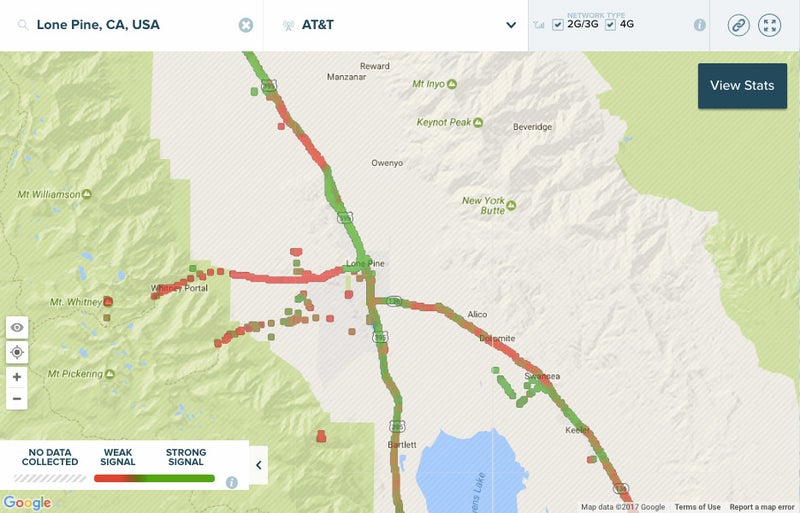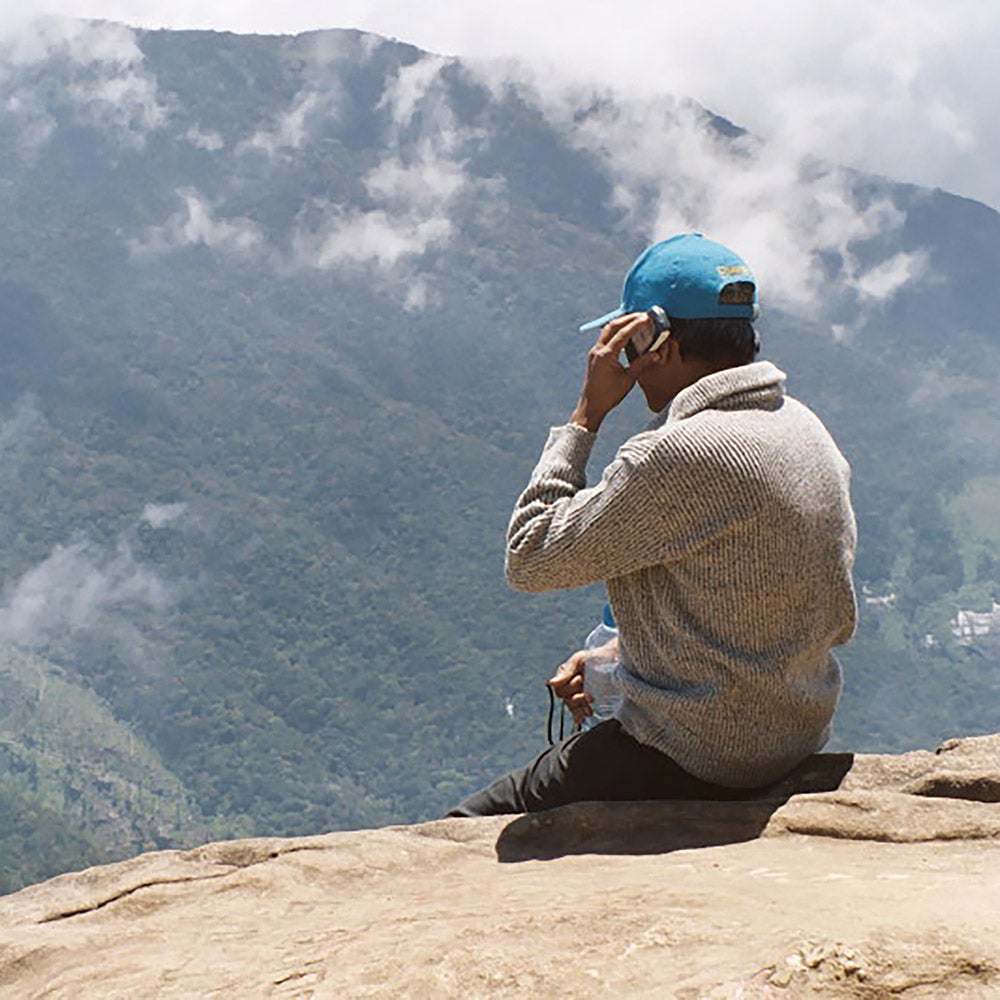Whether it’s dialing 911 in an emergency, streaming music in camp, or checking in on weather radar, phones are playing an increasingly important role in the outdoors. But, out in the woods, cell signal is often weak, or non-existent, and can vary from one moment to the next. Can learning the variables in the signal strength equation empower you to find better reception? One day, your life may depend upon it.
A couple weeks ago, I visited Santa Cruz Island, which is about 20 miles off the coast of Ventura, California, with my group of underprivileged kids. One of them asked a Ranger if she could find cell signal anywhere, and he explained that he could sometimes get a few bars on the beach at the island’s closest point to the mainland, but that the strength of that signal was intermittent, and he didn’t understand why. So I resolved to find out.
What Is Cell Signal?
You know it as the five bars on your phone’s display. The more you have, the better the signal, the faster the data, and the clearer the voice.
Your phone communicates with a cell tower via radio waves. That’s what transmits the photos, the text, or your voice. Those radio frequencies are in the UHF band, and range from 700 to 2,600 megahertz. We’ll get to what that means in a bit, but for now suffice it to say that.
This line-of-sight signal propagation can’t travel around the earth’s curvature and can be obstructed or refracted both by physical obstacles (like a hill or forest), and atmospheric conditions.
The outright range isn’t just limited by the horizon though. Because there’s a finite number of radio frequencies available, cell providers are issued only a certain number, and have to make sure those emitted by one tower don’t interfere with those emitted by another. These cells of signal from the antenna fitted to a tower give cell phones their name.
In dense urban areas, microcells may only transmit a powerful enough signal to propagate several hundred yards, so as not to interfere with the next antenna. In less populated rural areas, a fewer number of antennas emit more powerful signals that can travel several miles.
How far can the radio signal from a cell tower travel? In a best case scenario, given a clear line of sight, no obstructions, ideal atmospheric conditions, and a powered-up cell tower, a normal phone has enough power to communicate with a tower that’s about 45 miles away. But, .
The signal transmitted by a radio tower halves in power when you double the distance. So, as you move away from a cell tower, your signal will weaken as you move farther away.
That 22-mile effective real world range is about right for that beach on Santa Cruz Island. It stands at the practical maximum range from cell towers in Ventura, so in ideal conditions, you get a weak, but usable, connection.
But why does that signal come and go?

How Water Affects Cell Signals
The high frequency wavelengths used by phones don’t travel well through water. Because water conducts electricity, it can reflect radio waves. And water vapor absorbs the energy of radio signals, and turns them into heat—the same thing that happens inside your microwave.
Basically, water blocks the radio signal between the tower and your phone.
How Air Temperatures Affect Cell Signals
Any observed correlation between signal strength and atmospheric temperature . The strength of signal reaching your phone should not be impacted by a temperature change alone.
It’s also important to understand that the line-of-sight propagation of UHF frequencies differs from the way very low frequencies bounce between the earth and ionosphere, therefore traveling very long distances. Atmospheric conditions that may allow a ham radio operator to bounce their signal to the opposite side of the world will not allow a line-of-sight cellular transmission to extend its range.
���ܳ���temperature inversions, where a layer of warm air is trapped above a layer of cool air, can create atmospheric “ducts” that bounce radio signals over longer than usual conditions. While the short waves of UHF transmissions aren’t typically very bouncable, a cell tower located in a layer of clear, cool air that’s under a layer of warm, damp air, may extend the reach of its transmission.
Cell Signals In Real World Conditions
Rain
The larger the drops, and the more of them there are, the more cell signal will be scattered. .
Fog and Clouds
Like rain, but with many more, smaller droplets. How fog affects your cell reception is dependent on which frequency range you’re operating in. Below 2,000 gigahertz, it’s not a huge factor. But, above that number, fog can seriously scatter the signal. Some of the latest 4G LTE bands operate at those frequencies. .
Snow
Ice crystals are far less dense than liquid water, especially in snowflake form, so they don’t have nearly the same effect on signal propagation. But very heavy snow may still refract radio waves, reducing your signal strength.
Hail
It all depends on the size and density of the hail in question. But, ice is less dense than water, and hail doesn’t tend to fall as thickly as rain, so its refraction of cell signal will be less, too.
Lightning
The huge charge of a lightning bolt can cause electrical interference, and can damage antennas, power sources, and other transmission equipment.
Wind
Wind alone does not interfere with radio signals. But, the weather conditions it’s associated with, as described here, can. Wind can damage exposed cell towers, power lines, and the electrical equipment associated with them.
Bodies of Water
There’s no or few obstructions to radio signals traveling across bodies of water, and cool water temperatures can create surface inversions that trap a layer of cool air close to the surface. Both factors together may mean you’ll experience longer than usual reception ranges between two points separated by a body of water. Residents of Detroit may be familiar with this phenomenon—they regularly find themselves connected to a cell tower in Canada, just across the Detroit River.
Trees
The dense biomass of a forest contains a ton of water, so the trunks and leaves of trees combine to reflect and absorb radio signals. In a deciduous forest, you may get better reception in winter than you will in summer, due to the trees shedding their leaves, opening up space for radio transmissions to pass through.
Physical Obstructions
The most common limitation on cell reception is simply the presence of physical obstructions. Because UHF signals are line-of-sight, a mountain between you and the cell tower will prevent radio waves from reaching you, even if you’re within a short distance. Buildings with lots of metal used in their construction, vehicles, and even your body can also interfere with signal.
How To Use This Knowledge
At first glance, it may not seem like all this has a ton of applicability to your day-to-day life. If you don’t have reception, you don’t have reception. When that Ranger is standing on that beach, trying to text his boyfriend, it doesn’t really help him to know that the fog bank between the island and shore is the reason he can’t say, “I love you.”
���ܳ���I’m again reminded of the case of Karen Klein, who spent her Christmas eating twigs and drinking pee when she attempted to walk for help after her family became trapped in a snow storm. She managed to cover 26 miles through a blizzard, but the next day, her husband (who stayed behind with the kid and car) simply walked to the top of an adjacent hill, and was able to call 911.
Did she know to try to achieve line-of-sight with a cell tower by heading to high ground? Did she know her reception might improve enough to make place a call after the storm ended? Judging by the pee drinking, the answer to both was no. Hopefully this knowledge can empower you to make smart decisions.
You can also take this one step further. In some conditions, switching away from LTE to a 3G network may give you some signal. Many phones allow you to toggle this setting—it’s worth trying.
While planning a camping trip, if cell reception is important, you could also compare the location of cell towers with local topography. If your carrier has a cell tower less than 22 miles across a body of water, chances are your phone will be able to communicate with it in good weather. If there’s a cell tower on a hilltop less than 22 miles away from another hill with an unobstructed line-of-sight between them, then that might be a good spot to camp if you want to be able to upload your Instagrams. The closer, and the more unobstructed, the better. Thermal inversions and clear, dry weather help, too.
It’s also worth noting that you can call 911 across the networks of carriers you don’t subscribe to. So, if you’re a Verizon customer, and you happen to be somewhere that Google Fi offers better service, you’ll still be able to call 911. Your phone may not display signal bars to correspond with the presence of a rival’s cell signal, but the call will go through nonetheless. When in doubt, just dial 911 and see what happens.


